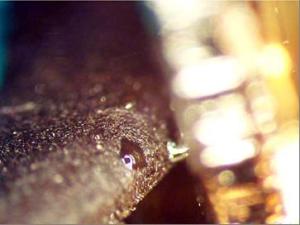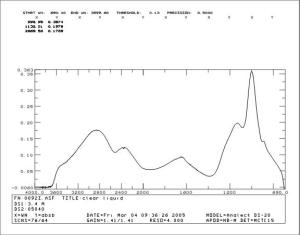Liquid Contamination on Relays
Gideon Analytical Laboratories performed failure analysis on several Sky CKC-1C-12VDC 12A/120V relays. These relays have a contact resistance of 100 Mohms and have a surge resistance of 1000V. The devices had a liquid on the inside surface and corrosion on several of the leads. The liquid and corrosion is pictured at the top left.
The drop was analyzed using FTIR. The liquid was thought to have come from the flux residue and, therefore, an organic analysis FTIR is required as opposed to inorganic (XRF). The pH is 0.0. The liquid is very acidic. Since the liquid appears to be inorganic, an XRF was performed. A 2-microliter aliquot of DI water was added to a region showing a large number of droplets. The drop was moved about the surface and then recovered using a 2µ1 capillary and transferred to a Prolene film mounted on an XRF sample cup. The XRF sample cup consisted of Chemplex XRF sample cup cat. No. 1430 and a Prolene thin film cover (4µm Prolene, Chemplex cat. No. 426). The backside of the sample cup was removed to permit application of the sample solution to the back of the Prolene film.
XRF was carried out using a Thermo Kevex Omicron X-ray fluorescence spectrometer. The system was fitted with a 2 mm aperture and was calibrated using a Kevex 316 SS standard with Fe and Mo lines as reference. The samples were analyzed in air with 25 KV X-rays and thus only elements with atomic number larger than aluminum would be detected. This material appears to be a filled, glass fiber reinforced material containing a phosphorus species along with an antimony/bromine fire retardant package. The original formulation likely contained antimony oxide and a poly-brominated organic, such as diphenyl ether or a tetrabromo BPA polyester or polycarbonate.
The acid did not get into the package in the form of phosphoric acid alone. It probably came in with a water borne flux or waterborne flux. The solvent evaporated over time leaving the acid. This acid will be a chronic problem for the life of the device because it is corrosive and will not evaporate. With failure analysis performed by Gideon Analytical Laboratories, electronics companies can receive candid and accurate information about how and why failures occur.

Acid on encapsulation

FTIR of contaminate